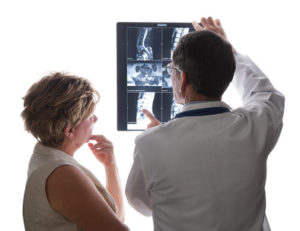Osteoporosis is a condition that affects many of us. It gradually becomes more common as we age but can also occur in those who are younger with osteoporosis-associated conditions. But what can we do about it?
Firstly lets look at what osteoporosis is.
Osteoporosis is a condition that develops slowly over several years. It causes a weakening of bones and therefore an increased risk of fractures. Osteopenia is a decrease in bone mineral density that is not yet bad enough to be categorised as osteoporosis.
So what causes osteoporosis?
Although a loss of bone mineral density is common throughout life, one of the main factors that speeds this up is menopause. Unfortunately this means that women are more likely to develop osteoporosis than men.
Other common causes and disorders linked to osteoporosis are:
- Long term use of oral corticosteroids
- A low body mass index
- Heavy drinking/smoking
- Genetics
- Celiac Disease
- Parathyroid conditions

So how is osteoporosis diagnosed?
A DEXA scan measures bone mineral density. Your results will then be measured against those of a healthy young adult and against someone of your own age. The deviation between the two will generate what is known as a T score.
Your T score results can be assessed as follows:
- above -1 is normal
- between -1 and -2.5 is defined as a decreased bone mineral density compared with peak bone mass
- below -2.5 is defined as osteoporosis
So how is osteoporosis treated?
Many factors have been found to help those with osteoporosis:
- Exercise
- Vitamin D supplements
- Stopping smoking and reducing alcohol intake
- Eating foods rich in calcium and vitamin D.
To read further about exercises that benefit those with osteoporosis, please go to the pinnacle posture blog located here: https://www.pinnacle-posture.com/blog

Michael graduated from Oxford Brookes University with a Masters Degree in Osteopathic Medicine. Whilst at University, he gained a Diploma in Sports Massage. After University, he furthered his studies by qualifying as a Medical Acupuncturist. He will use all three therapies individually or combine them, depending on the condition.
Michael assesses aspects of the patient's lifestyle that may contribute to their condition, believing that incorporating advice regarding these factors into an Osteopathic treatment will provide further benefit. He looks further than the presenting condition to identify any underlying causes. He then treats the condition using a range of techniques, advice and exercises aiming to prevent the condition returning.
Michael also has a large passion for music and has composed scores for theatre productions, artists, authors and weddings. During his free time he enjoys walking his dog, going to the gym and running.
DISCLAIMER:
All the information provided by Michael Garrett/Pinnacle Posture and any associated images/videos are strictly for informational purposes only. The information is not intended as a substitute for advice from your health care provider or physician. The information provided by Michael Garrett/Pinnacle Posture and associated images/videos cannot be used to make a diagnosis or treat any health condition. Michael Garrett's/Pinnacle Posture's blog posts, comments and website contains general information about medical conditions and treatments. The information is not medical advice, and should not be treated as such. The medical information in Michael Garrett's/Pinnacle Posture's blog posts, comments and website is provided “as is” without any representations or warranties, express or implied. Michael Garrett/Pinnacle Posture accepts no liability for, including but not limited to, any injury or accidents caused by the use of any information provided in its blog posts, comments or website.


There is a history of Osteoporosis in my family. I’m in my late 50’s and know I have osteopenia
on November 22, 2017 at 11:06 am Carmel Josephine Bouchercertainly and possibly deteriorating into osteoporosis now that I have all menopausal symptoms. I am gluten free but am not apparently celiac although display many of symptoms. I am single mum with 14 year old and buy supplements regularly but constantly straining to maintain healthy and try to eat sensibly but struggle to find a good supplement that I can afford for osteoporosis. My doctor is not particularly helpful. I have Hashimotos which is added complication. Any suggestions? Your information is excellent very clear and helpful
Hi Carmel,
Thanks for the kind words regarding my blog post and I’m sorry to hear you are stuggling with osteopenia.
I’m afraid that, as an Osteopath, all I am allowed to do is present research on a topic – I do have further Osteoporosis research on my website.
I am unable to give specific advice to individuals on their conditions without doing an assessment first.
on November 27, 2017 at 2:08 pm Mike GarrettI’m sorry that I can’t help you further but I wish you the best of luck.
Thanks for sharing………
on October 30, 2018 at 8:27 am Mr Suman